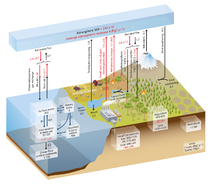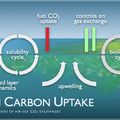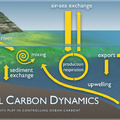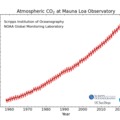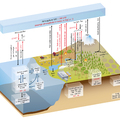Carbon Educational Tools
Educational information on the carbon cycle
Carbon is an integral part of the Earth system and the building block of life. Its presence in the atmosphere as carbon dioxide (CO2) and methane (CH4) is critical to maintaining a habitable climate. It plays a major role in the chemistry, physics, and biology of the oceans. Carbon is currently also the dominant element in human energy use, forming the basis of coal, oil, and natural gas – hydrocarbon compounds derived from plants that removed CO2 from the atmosphere hundreds of millions of years ago. The continual transport and transformation of carbon in the Earth’s atmosphere, rivers and oceans, soils, rocks, living organisms, and human systems is what we call the global carbon cycle.
Human activities have substantially altered the Earth’s natural carbon cycle. Human use of energy has grown exponentially in the last century, and the extraction and combustion of fossil fuels have replaced society’s early reliance on renewable energy sources such as biomass, wind and running water. Fossil carbon, carbon that was removed from the “active pools” of the earth system (plants, fresh water systems, oceans, soils, and the atmosphere) and buried in the Earth’s interior, is being returned to the active carbon cycle. As a result, carbon dioxide is building up in the atmosphere and in the oceans. In addition, human use of land for activities such as farming, forestry, and urbanization has resulted in a gradual release of soil and plant carbon, further increasing the amount of carbon in the atmosphere and oceans. For a summary of the latest global carbon budget visit the Global Carbon Project website.
Understanding the Earth’s carbon cycle is both a challenging intellectual problem and an urgent societal need. The impacts of human-caused changes in the global carbon cycle will be felt on the Earth for hundreds to thousands of years. For more information on the connection between carbon and climate visit the University of Wisconsin carbon and climate website.
Direct observations and process-based understanding of the global carbon cycle are needed to determine how the cycle is being modified, what the responses are to those modifications, and how best to develop sound climate change mitigation and adaptation strategies. To see some of the observations that contributes to improving our understanding of the global carbon cycle visit the NOAA Earth System Research Laboratory’s data products and visualization website.
For other carbon cycle educational resource ideas download the CarboSchool’s educational booklet.

